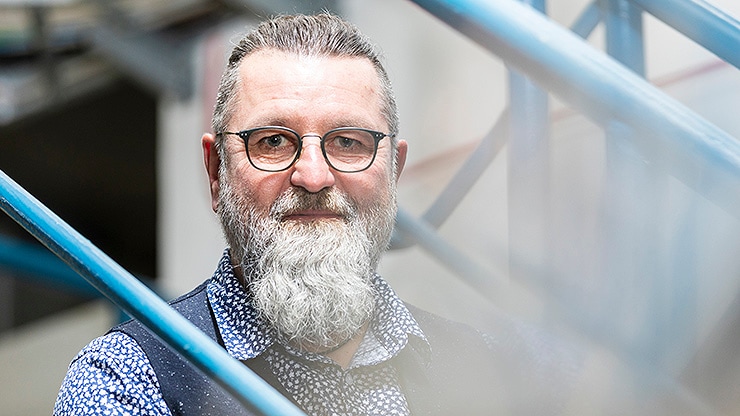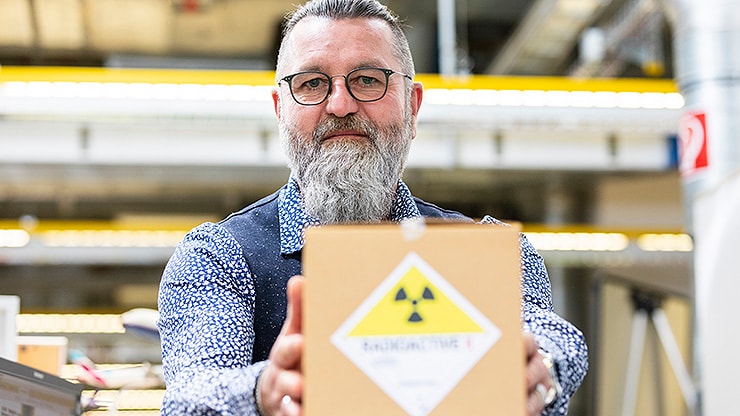Radium 223 and the Fight against Prostate Cancer

Bayer’s treatment for advanced prostate cancer which has spread to the bone is one of the company’s very special products. It is a targeted alpha therapy and production and shipping are a constant challenge.
“Somewhere in the world, there is a seriously ill patient who urgently needs his prescribed medicine that he receives to fight his prostate cancer. Every passing day counts,” says Ingo Ocklenburg, Global Strategic Sourcing Manager in Bayer’s Procurement organization.
It is his job to use his own transportation concept in order to ensure the drug product – which is manufactured at two production sites in Norway and the United States – reaches patients in the shortest possible time, wherever in the world they may be. “We can deliver to Australia – the farthest distance we have to cover – within 48 hours,” Ocklenburg says, adding: “I’ve been working in air transportation since 1982, and I’ve never had to deal with a product as challenging as this one before.”

The medication was developed for patients with advanced prostate cancer that has spread to the bone and has been on the market since 2013. Since it contains radium 223 dichloride, which targets the cancerous cells in the bones of prostate cancer patients, the preparation poses unique challenges for production and sales. Each patient who is treated with this radioactive substance – it radiates to a total of just 0.1 millimeters, roughly the circumference of ten human cells – receives a personally calculated dosage. The amount required depends on the patient’s body weight, among other things. For example, someone weighing 120 kilos might need two separate vials, whereas a part of a single one could be sufficient for a 50-kilo patient.
One of the special properties of this product is that is the only approved targeted therapy that is emitting alpha particles. Those alpha particles are of high energy, yet they only travel very small distances in the body, which means that damage to the tissue surrounding the cancerous cells is minimized.
The time factor therefore plays such an important role because the activity of the medication is reduced gradually – radium 223 dichloride has a half-life of 11.4 days, meaning the radiation is only half as strong after that period. After 28 days, the activity of the product is too low to be used for medical treatment and the medication has expired its shelf life and must be wasted. For supply chain, production and sales, this means precision and strict attention to deadlines are required. Every production unit, transportation and delivery is a race against time.
- 1/7
- 2/7
- 3/7
- 4/7
- 5/7
- 6/7
- 7/7







For Ocklenburg, the logistician, this means he always needs at least two transportation options lined up – should one fail, then the back-up solution is called upon. For this product we never use standard solutions. “The logistics department was brought in at a very early stage of product development, and that was key to the success,” Ocklenburg says.

From the time of initial launch, the demand for this product increased constantly. “We doubled our production volume between 2014 and 2018. The radium-223 from Bayer is now by far the world's largest injectable radioactive product,” says Thomas Birger Eden-Jensen, Head of Product Supply Operations for the Pharmaceuticals division in Oslo, Norway.
Despite all the experience gathered with the medication over the years, there is still room for optimization. “We are currently working on boosting efficiency, reducing costs and making our production and supply chain as lean as possible,” says Eden-Jensen. Even though there is always room for improvement, asked to rate the current state of production and supply chain on a scale of 0 to 10, he forthrightly says, “8”.

Safety first – how the product is packaged for transportation
Bayer designed a special container for transporting its radiopharmaceutical product. After all, it is important to be 100 percent certain that no radiation inadvertently escapes from a radioactive substance. From a transportation point of view, it is considered a “hazardous material”, and extremely strict safety requirements must be met during transportation, be it by road, by water, by rail or in the air.
Bayer’s targeted alpha therapy was licensed for market in May 2013. A year before, work had already begun on solving the packaging issue. Ocklenburg says the transportation container was optimized over several stages. The radioactive saline solution in the 10-milliliter vial is first contained in a lead box, which itself is surrounded by a polystyrene casing. “A little cube with a lead container,” Ocklenburg calls it, and its task is to ensure the medication gets safely from its place of manufacture to the patient.
Packaged ready for transportation, it is contained within a radiation-proof cube measuring approx. 20 cm x 20 cm x 20 cm. According to Ocklenburg, the goal is to make the cube even smaller and easier to handle. In doing so, however, there are safety regulations to consider – there are minimum dimensions for hazardous goods containers. Safety first.




















